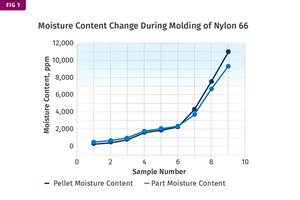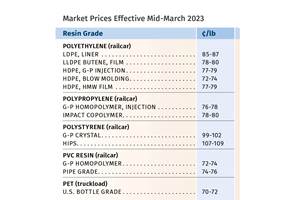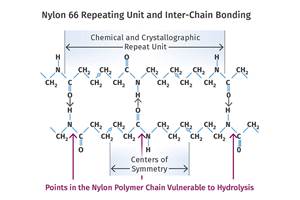Long-Fiber Thermoplastic Liquid Crystal Polymers
Sumitomo’s first Sumikasuper SCG LCPs to feature carbon and glass fiber reinforcement targeted as replacements for alloys of aluminum, magnesium and steel.
A new family of long-fiber thermoplastic (LFT) compounds with high-performance liquid crystal polymer (LCP) matrices reinforced with 13-mm chopped carbon fiber or fiberglass has been developed by Sumitomo Chemical Advanced Technologies. The new materials are currently undergoing customer evaluations in several industries and developmental quantities of two grades — Sumikasuper SCG-379 with 30-50% fiber-weight fraction (FWF) E-glass and Sunikasuper SCG-420 with 30-40% FWF high-modulus carbon fiber — are available to interested parties for testing. An LCP matrix and the option for carbon fiber reinforcement have been shown to significantly upgrade the thermal and mechanical performance available from LFT technology and the products are being targeted to replace alloys of aluminum and magnesium as well as steel.

Pelletized LFT compounds were originally developed in the 1990s to increase the mechanical performance of short-fiber injection moldable thermoplastics in the automotive industry for a variety of semi-structural interior and exterior panels. Given these automotive roots, the vast majority of all commercial LFT products feature fiberglass-reinforced PP, although higher temperature nylons 6 and 66 have been gaining marketshare in this segment. Beyond automotive, which still consumes the majority of LFT materials, the products have expanded into applications in the sporting goods, power tool, and appliance industries. And commercial carbon fiber-reinforced LFT grades are available in PP, nylon, TPU, PPS, PEEK, and PES.
The new LFT-LCPs grades have been under development for four years. The most challenging issue to overcome was finding the right fibers to maximize performance of the LCP compounds. Said Sumitomo product manager Takayuki Sugiyama, “It has long been established that mechanical properties of plastics increase with longer fiber lengths. However, it also is well known that rarely do fibers longer than 2 mm survive the screw, runners, and gates to make it into the mold and the molded part during the injection molding process. Therefore, the advantage of starting with significantly longer fiber reinforcement in LFT materials is not being fully realized.”
Added Sumitomo senior manager Tomohiro Sato, “Given the ease of processing LCP materials, we felt we could take advantage of their low melt viscosity and low molding pressures to better preserve fiber length during injection molding.” He noted that these materials are being positioned against lightweight metallic alloys and even steel where they offer comparable or higher mechanical performance at much lower weight, better energy management, elimination of corrosion, reduced manufacturing and finishing steps, and very-fast processing times, which will help offset initial higher material costs.
One especially promising area of research with the new compounds has been molding them into a variety of energy-management structures and then conducting crush tests to see how much energy they absorb before failure. Test results on structures ranging from ribbed hat and cone designs to a variety of honeycombs show the LFT-LCP grades offer excellent energy absorption, exhibit very-controlled crush characteristics, and produce no sharp shards during ductile failure. This suggests the materials may be good candidates for crash structures (e.g., bumper crash boxes and rocker and pillar reinforcements) on passenger vehicles. Owing to their high thermal and broad chemical stability, LCP parts can be mounted to the body-in-white (BIW) during initial vehicle build and travel through the electrophoretic coating (e-coat) lines where rust-prevention coatings are applied to vehicle structures. The ability to survive e-coat makes it easier to use such materials in chassis structures, since their use does not require changing the way vehicles are assembled. Other automotive uses could include rails and support structures on sunroof systems and seating components. Outside the automotive industry, high-end sporting goods and industrial uses such as end of arm tooling for robots are also being explored.
Although no firm date has been set for commercializing the products, researchers say they are busy working with industry partners to collect technical data and build case studies that demonstrate how well the LFT-LCP compounds solve existing industry challenges.
Related Content
What's the Allowable Moisture Content in Nylons? It Depends: Part 2
Operating within guidelines from material suppliers can produce levels of polymer degradation. Get around it with better control over either the temperature of the melt or the barrel residence time.
Read MorePrices of Volume Resins Generally Flat or Lower
Exceptions in early March were PP and PS, which moved up solely due to feedstock constraints, along with slight upward movement in PVC and PET.
Read MoreGeneral Polymers Thermoplastics to Further Expand Distribution Business
NPE2024: Following the company’s recent partnership buyout, new North American geographic territories are in its sight.
Read MoreWhat is the Allowable Moisture Content in Nylons? It Depends (Part 1)
A lot of the nylon that is processed is filled or reinforced, but the data sheets generally don’t account for this, making drying recommendations confusing. Here’s what you need to know.
Read MoreRead Next
People 4.0 – How to Get Buy-In from Your Staff for Industry 4.0 Systems
Implementing a production monitoring system as the foundation of a ‘smart factory’ is about integrating people with new technology as much as it is about integrating machines and computers. Here are tips from a company that has gone through the process.
Read MoreSee Recyclers Close the Loop on Trade Show Production Scrap at NPE2024
A collaboration between show organizer PLASTICS, recycler CPR and size reduction experts WEIMA and Conair recovered and recycled all production scrap at NPE2024.
Read MoreFor PLASTICS' CEO Seaholm, NPE to Shine Light on Sustainability Successes
With advocacy, communication and sustainability as three main pillars, Seaholm leads a trade association to NPE that ‘is more active today than we have ever been.’
Read More


























